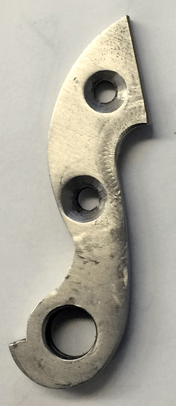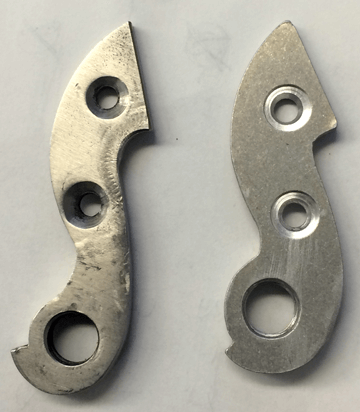
Small Cheap Part....Big Expensive Problem!
Replaceable derailleur hangers and the problems they can pose
 Several years ago, I wrote an article called 'Chaos, the new standard'. That article holds so much truth even today that I thought a follow up was in order. So, here it goes. A company that's been around for years, as we have, will tell you the importance of standards. This is a short article detailing one such detour that we took in the 1980's.
Several years ago, I wrote an article called 'Chaos, the new standard'. That article holds so much truth even today that I thought a follow up was in order. So, here it goes. A company that's been around for years, as we have, will tell you the importance of standards. This is a short article detailing one such detour that we took in the 1980's.
What are standards, and why should you care? If you are a person who wants to buy a bicycle that you will ride for 20 years plus, then standards mean a lot to you. For instance, I ride a Rodriguez road bike the we built here in 1999, and I'm still riding it today. I consider myself a Forever Bike person. I will still be able to buy parts for this bike in 20 years too. Any part that needs replacing we will have in stock. That's because it's built around ISO standards (International Standards Organization). ISO standards were settled upon by the bicycle industry in the 1970's in an attempt to make sure that people could get their bicycle fixed in just about any country, and well into the future. It's worked miraculously....until recently.
- 1.) Bill walks into our shop (in 2019) with a bicycle made in the 1979 (40 years ago) to ISO standards. No matter what brand it is, or country it was made in, we can easily fix it. Not only that, we will almost certainly have replacement parts in stock! What if Bill wants to upgrade this bicycle to modern shifters, tires, cranks, hubs, headset....you name it? No problem! We do this kind of thing often here in our repair shop for folks. All modern parts can fit on Bill's bike because it was built to ISO standards.
- 2.) Jim walks into our shop with a bicycle made in the 1979 to non-ISO standards. Maybe it's a French or Italian bike built by a manufacturer that rejected the ISO standards. Or, it could be a manufacturer that used proprietary bearing sizes, or other proprietary parts. Jim will more than likely not be able to get the parts needed to get this bike back on the road....at least, not easily. Parts will have to be ordered (if still available), or even manufactured custom to get this one back up and running. This is also a scenario we see here at R+E Cycles. Most often, these bikes are just retired from service, as manufacturing custom parts is quite expensive.
Planning Obsolescence:
Will a company make these parts available to you as long as you own your bike? How about 30 years down the road? Will they even be in business in 30 years? What if your expensive bicycle has a proprietary small part that is required for the bike to be rideable, and 30 years from now that small part breaks? Does this happen? Absolutely! As a matter of fact, one company used such an item back in the 1980's that became quite a problem for them in 2002. That company was us, Rodriguez Bicycles.
Here, we'll narrow our article down to just one small, proprietary part. It represents the problems of all non-ISO parts, and it's the only one that we adopted. As a company that cares about our customers long term experience with our bicycles, it came back to bite us.

1980's American Mfg. Derailleur hanger
You see, in 1988, Angel Rodriguez selected a manufacturer, American Mfg., who worked specifically in aluminum to build Rodriguez aluminum tandems. He set them up with a full tandem fixture and then hired them to build tandems to be labeled and sold as Rodriguez tandems all over the U.S. This company had a specific design for a very small part on their frames called the 'replaceable derailleur hanger'. This is a small, inexpensive part that attached to the frame by the rear wheel. The rear derailleur is mounted directly to it. The bicycle cannot be ridden without this part, even though it was just a $5 part back then. Many bicycles today use the same type of part, but not the same design....as you'll discover if you keep reading.
Quick trip through history:
Why was this part even used? This was a new feature in the 1980's, and had come about because of the more fragile nature of aluminum frames. Customers who bought aluminum bikes like Cannondale, Klein, and American Breezer were discovering a somewhat big flaw in aluminum as a bicycle frame material. If the bike was in a wreck, even just a little 'tip over' that caused the derailleur hanger to bend, it could result in an un-repairable frame.
On a steel bike, a bent derailleur hanger is a very small issue. It's fixed by a process called 'cold setting'. That's a fancy word for basically just bending the metal back to it's original shape. It's an easy, inexpensive repair that every bike shop is equipped to do. Since just about all bikes were steel, it didn't enter anyones mind that this would be a big problem.
Aluminum has a different quality than steel though. Once an aluminum frame is welded and aligned, it goes through a process called 'artificial aging', or 'heat treating'. Once heat treated, the aluminum can no longer be bent, and then bent back into position like steel. If it does get bent, even just a little bent from a tip over, it fractures. When you try to re-align it, it will then break off. Since this is part of the frame, it ruins the frame.
So then, aluminum bicycle manufacturers had to come up with a way that their customers could have this fairly common situation solved. The result was to design a small part that bolted or riveted onto the frame for the derailleur to mounted to. The part was made intentionally to be a lot weaker than the frame itself. This way, if the bike tipped over, or was crashed, the weak hanger would bend or break instead of the frame. A new part could be purchased at the dealer for $5 ~ $10 and installed. This was a fine idea for aluminum frames, and when carbon frames became prevelent, the same technique had to be adopted as the dropouts (the part of the frame that the wheels mount to) are made from aluminum as well.
Obsolescence Warning:

There's even an entire entire website devoted to selling them
Back to our Rodriguez story. In 1988, little thought was given to the fact that we were using a proprietary derailleur hanger on expensive tandems being sold all over the United States. But, in the 1990's, our relationship with that aluminum bicycle manufacturer came to an end. Or, rather, they went out of business. So, the derailleur hangers we had in stock at the time became very important. Not only the Rodriguez tandems we sold needed them, but so did all of the other bikes that company had made throughout the 1980's. Since the part was designed to fail easily, we were going through them quite fast. It wasn't long before we limited the sale of these to owners of Rodriguez branded bicycles only. Since we are Rodriguez, we felt the need to support our brand, and try to keep our tandems on the road.

Left: 1980's hanger. Right: New, stronger, better shifting design.
We learned our lesson about proprietary parts. Although we are happy to build any bicycle that a customer wants, non-ISO parts or not, we don't recommend them to our customers who want a forever bike. If we had not sold Rodriguez branded bicycles using this inexpensive part, it would no longer be available. All of these 25+ year old bikes would be retiring. Just this morning I received another order for one of these parts from a bicycle owner in Norway. Another bike kept on the road. I love it! He lucked out that Rodriguez is still in business and willing to do what it took to keep our bikes going strong. Note: Not many manufacturers will gear up to make an obsolete part for a model they haven't sold in 30 years.
The point of this story is to educate the reader as to the difference between 'New and Cool' and ISO standard. Sometimes the 'New and Cool' part is actually better, sometimes it's not. Either way, most 'New and Cool' will not be around in 20+ years. I can rattle off several 1980's and 1990's examples of such designs that have since rendered many expensive bikes useless. I think it's important that consumers consider this fact before they invest $5,000 or more on a new bike. Would you be disappointed if you couldn't ride your $5,000 bike in 10 years? If so, then you should consider the manufacturer and their policies regarding ISO standards. Or, just order a Rodriguez ;-)
Thanks for reading - Dan - April. 2019






